A DELECTABLE PEACH
/13 Comments/in Fruit/by Lee ReichA Time Machine
A few days ago, a fuzzy orb that I held in my hand became a time machine. This time machine was a peach, and time travel took place immediately after I took a bite out of it. There I was, no longer eating the peach on my friend Wendy’s farm — Wendy is a botanical artist, https://drawbotanical.com — but in the backyard of my youth, biting into a peach from our backyard tree. (Our home “orchard” also consisted of two crabapple trees, whose fruit was morphed under the direction of a great aunt into jelly, and a pear tree that I remember bearing only one fruit that I watched daily only to find it, one day, gone, picked prematurely by my sister.)
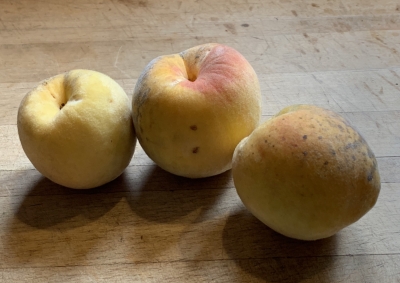
Back to the time machine peaches. These peaches would never sell at a supermarket, even a farmers’ market. Their skin was very fuzzy and a washed out yellow color, some with just a hint of a blush. I remember, when I worked for Cornell University Roger Way, the apple breeder at the time, bemoaning the fact that “Americans eat with their eyes.” Spots from peach scab disease on many of the fruits did nothing to increase their visual appeal.
“Would never sell,” that is, unless a taste was offered. Protected within that admittedly ugly skin was a meaty, golden yellow flesh. The flesh was sweet and, in contrast to most peaches these days, very rich-tasting, with a strong peachy flavor. It’s that peachy flavor that whisked me backwards in time.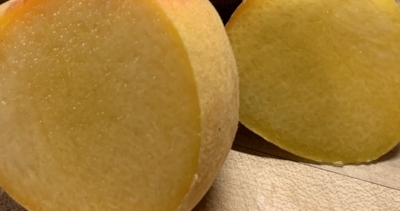
I Make a New Peach Tree
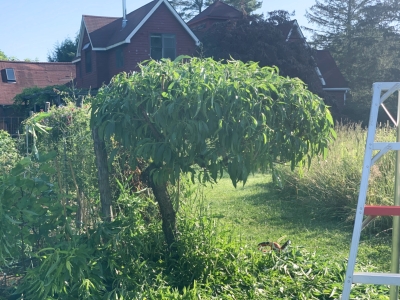
Long gone peach
This year has been the best ever fruit year in decades around here, even right here on the farmden, where the low-lying site is not very fruit-friendly. Peaches always fail here; a few weeks ago I finally cut down my one tree. Twice over the past years I planted apricot trees, knowing that they are one of the fruits least likely to succeed around here. I was right; they are long gone.
Against my better judgement I am going to once again venture into peachdom. Perhaps Wendy’s peach is resistant to peach ills: brown rot, plum curculio, oriental fruit moth, bacterial spot, and peach scab. (Yes, her fruits were afflicted by scab, but not enough to diminish the pleasure of biting into them.)
Wendy isn’t sure of the variety name of her tree so I can’t order that one from a nursery. No matter.
Pits saved from some of the fruits can be grown into whole new trees. Seed-grown peach trees grow quickly and can take only three or four years before their branches are adorned by fruits. Plant a peach pit now, and it will not sprout until next spring, even if you keep it warm. Like other temperate-zone fruits, the seeds need to be stratified, that is, they must experience winter before they’ll sprout. If they sprouted now, the young, tender seedlings would succumb to winter cold.
Plant the pit outdoors, and it will be naturally stratified. I prefer to fool the pit by cracking the outer shell, soaking the seed in water for a few hours, then putting it in a plastic bag, along with moist potting soil, in the refrigerator. Refrigerator-stratified seeds sprout more quickly than outdoor planted seeds because once the outdoor-sown seeds have experienced enough cold, a total accumulation of about 1,000 hours of temperatures between 30 and 45 degrees Fahrenheit, they have to await spring warmth before they’ll grow.
Seeds stratified in the refrigerator will often sprout in the bag within a couple of months, at which point they need to be planted. I plan to pot them up and let them grow in the greenhouse.
Seed-grown fruit trees generally don’t bear fruit identical to the fruits from which the seeds came. It depends on what variety pollinated the flower that became the fruit, and how the chromosomes got juggled around. Peach trees are self-pollinating, which reduces the variability from fruit parent to fruit child, so there’s a good chance that a seed grown peach tree will yield tasty fruit. In contrast, plant an apple seed and there’s about one in 10,000 chance that the fruit from the resulting chance will even be edible.
If I wanted an exact replica of Wendy’s peach, I could beg a branch from her tree and graft it onto a peach rootstock. What’s a peach rootstock? It could be any peach tree grown from seed.
And Almonds!
Despite apricot’s strong nomination for the tree crop least like to succeed around here and, actually, pretty much everywhere in eastern North America, it does not win the prize. Almond trees are less likely to succeed. With that said, in this best of all years for fruit, here in the Northeast, at least, Wendy managed to harvest her first (and perhaps her only) crop of almonds this year.
Almonds are closely related to peaches. Their common ancestor diverged six million years ago with the separation resulting by the lifting of the Himalayan massif. Both plants suffer from the same insect and disease problems.
Two characteristics put almonds in the most likely to fail category. First, in humid climates, the nuts themselves are apt to spoil. And second, almonds have a very low chilling requirement. (Just as seeds have chilling requirements before they will sprout, flower and stem buds also have chilling requirements before they can sprout.) With a low chilling requirement, almonds would likely break dormancy and flower with the first hint of warm weather in spring, then succumb to likely subsequent frosts.
But not this year.
Needless to say, I will not be giving almonds a try on my farmden.

Almond illustration, by Wendy
FOXY GRAPES
/14 Comments/in Fruit/by Lee ReichA Bad Rap
The word foxy has not been complimentary to grapes. It refers to the dominant flavor in one of our native species, the fox grape (Vitis labrusca). Around 1880, the botanist William Bartram went so far as to suggest that the epithet foxy was applied to this grape because of the “strong, rancid smell of its ripe fruit, very like the effluvia from the body of a fox.” (Others more generously suggested the epithet came about because foxes ate the grapes, or because the leaves resembled fox tracks.)
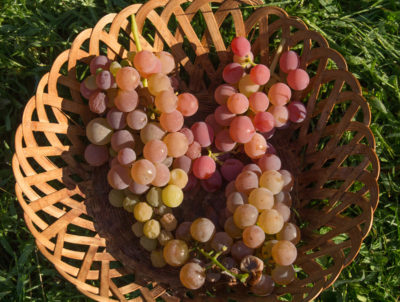
Glenora and Vanessa seedless grapes
Although native Americans ate this grape, early white settlers, well before the time of Bartram, had been unimpressed by the flavor. In 1672, John Josselyn wrote that fox grapes had “a taste of gunpowder.” Two Dutchmen visiting New York in 1679 recounted how they “went along the shore to Coney Island . . . and discovered on the roads several kinds of grapes still on the vines, called speck [fox] grapes, which are not always good, and these were not; although they were sweet in the mouth at first, they made it disagreeable and stinking.”
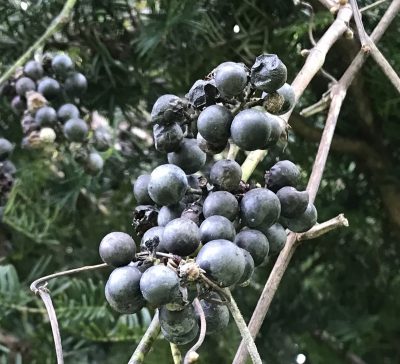
Fox grapes
Wherever white settlers landed in America, they attempted to establish plantings of the grape with which they were familiar, the European wine or vinifera grape (V. vinifera), which was the grape cultivated in the Old World since biblical times. In America, vinifera culture began as long ago as 1619, when the best vines and skilled growers were brought from France to establish a vineyard in Virginia. That planting and virtually all subsequent plantings in the East failed because vinifera grapes can’t tolerate the cold winters or the insects and diseases to which our native grapes are accustomed.
What’s the Difference?
In spite of repeated, futile attempts at growing vinifera grapes in the East, few people considered growing our tougher, native grapes before the nineteenth century. Only then were superior varieties developed, beginning with Catawba about 1820.

One reason for the delayed interest in fox grapes was because vinifera is the better fruit for wine, and it was not until the nineteenth century that fruits generally were appreciated for fresh eating. (“Wine” recalls another possible source for the epithet foxy; horticulturalist Liberty Hyde Bailey suggested in 1898 that the name arose due to “the lively foxing or intoxicating quality of the poor wine which was made from the wild grape.”)
As you might imagine, fruits of vinifera and fox grapes are quite different. You can pick out the difference from the grocer’s shelf today. The fox grape is represented by Concord: bite into a berry and the thick skin slips off the jelly-like meat, releasing a strong, aromatic, though not excessively sweet, flavor. The vinifera grape is represented by Thompson Seedless: eat the whole berry, tender skin and all; the fruit is sweet, with a neutral flavor. Vinifera berries are less apt to shake off the bunches, so ship better, which is one reason why Concord grapes usually show up in markets only near where they are grown.

Concord grape
I Like Foxiness
All this verbiage isn’t an academic exercise in grape history. If you grow grapes, as I do, survival of the vines and taste of the fruits is important. Vinifera are occasionally grown with success in the Northeast, but 300 years of mostly failure should teach something.
For those gardeners who strive for a grape akin to vinifera, there are hybrids between vinifera and fox grapes. Actually, most grape varieties these days are hybrids of vinifera, labrusca, and often some other species. Hybrids exhibit the full spectrum in flavor, hardiness, and pest tolerance, depending on which varieties were used as their parents.
If you live in a environment inimical to vinifera grapes and you’re interested in growing grapes closer in flavor (or lack thereof, in my opinion) to Thompson Seedless, hybrids such as Himrod and Lakemont are fairly cold hardy and can be grown at favorable sites, preferably south facing slopes in full sun. A bit more foxy, unfortunately only fairly cold hardy, is Vanessa, a delectable small berry which is pale red, crisp, sweet and flavorful.
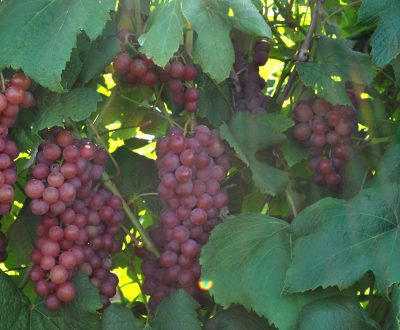
Vanessa grapes
I have grown one vinifera variety, thus far in a large pot in my greenhouse. This one, Perle de Csaba, and I’m sure some other viniferas, does have a distinctive, delicate flavor, besides being sweet and seedless, and wrapped in a tender skin.
Notwithstanding the previous testimony against foxiness in grapes, I happen to like my grapes foxy. And I’m not alone: Ulysses P. Hedrick, who wrote The Grapes of New York early in the last century, conceded that many vinifera grapes “are without character of flavor” compared to American grapes, which are “more refreshing . . . do not cloy the appetite,” and make a better juice. My taste preference is fortunate, because in my farmden, here in the bottom of the bottom of a frost pocket, grapes are particularly prone to both cold injury and disease.
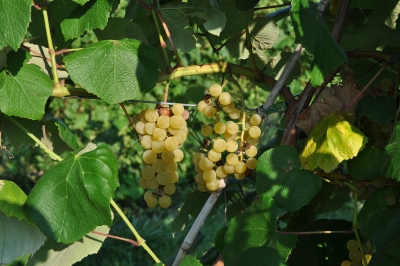
Edelweiss grape
Despite my affection for foxy grapes, for many years my farmden lacked a good ol’ Concord vine. I finally planted one about 6 years ago, ate the fruit for a couple of years, then decided the flavor didn’t warrant my growing it. Yesterday I tasted a friend’s Concord grapes and they were delicious. What’s up? Did my nursery source for my Concord vine mix up labels? Could the difference be due to terroir, a concept that takes into account almost everything: soil, climate, slope, sunlight, the geology and geography of a particular region, and as much more as needed to lend it a certain mystical quality? (I delve into terroir in depth in my book The Ever Curious Gardener.) I took a cutting to make a plant and in a few years will check out the flavor of that “Concord” here.
For the past few weeks, I have Elmer Swenson, a dairy farmer and grape breeder who lived near the Wisconsin-Minnesota border, to thank for the grapes I am eating. Some of my favorite varieties reflect his skill as a breeder. Swenson Red berries are medium sized, sweet, fairly foxy, and just slightly slipskin. I do wish that Edelweiss was not so vigorous, but the berries are deliciously sweet and foxy. Also delicious and foxy is Brianna. And for a variety leaning towards the vinifera end of the gustatory spectrum, there’s Somerset Seedless. Thanks Elmer.
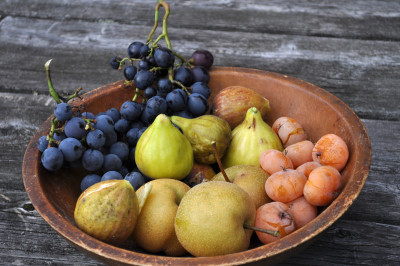
Fruit bowl with fig, grape, persimmon, nashi
HAVE SOME SYMPATHY
/9 Comments/in Design, Flowers, Soil/by Lee ReichSoil That is Too Good?
I don’t expect to elicit much sympathy from moaning about the problem with my soil here on the farmden; the problem is that it’s too good. Wait! Don’t roll your eyes or, worse, stop reading. Allow me to present my case.
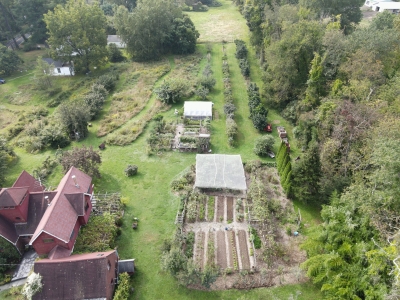
The setting: A valley cut through with a small river (the Wallkill River) in New York’s Hudson Valley. River bottom soil, specifically young alluvial soil, rich in nutrients, a silty clay loam with perfect drainage. Also naturally rich in nutrients. No rocks.
So what’s the problem? One problem is too much growth from plants that I’m not cultivating — weeds, everything from stilt grass and garlic mustard to wild blackberries and poison ivy to ash and cherry trees. Every minute of every day they are making the most of this rich ground and trying to insinuate themselves into my plantings. They creep into the edges of the vegetable gardens, settling in especially well right at the bottom of any fencing, where they are hard to weed out.
My land is backed by forest running up to hills, then mountains, with soil that’s pretty much the opposite of what I have down here in the valley. It feels like that forest is just waiting for me to let up weeding and mowing, ready to spring down here and engulf my plantings.
That feeling is pretty much borne out in the one-third of an acre meadow to the south. Once a year mowing keeps the meadow a meadow. Yet even in the few months of each growing season, joe-pye-weed and ragweed stand almost 9 feet high and goldenrod, monarda, and grasses grow densely.
Looking at the herbage more closely I see multiflora rose, staghorn sumac, grapevines, and other woody plants elbowing their ways in here and there. And cherry, red maple, red oak, and poplar trees keep trying to introduce their progeny into the meadow to morph it into forest. Which isn’t a bad thing except that I scythe parts of that meadow for harvesting the herbage, not woody plants, to feed my compost, and grow apples, kiwis, pawpaws, hazelnuts, and other fruits and nuts that I cultivate in and around the meadow.
Errant and Robust
Even some cultivated plants grow a bit too well here.
Crocosmia, for example. Towards the end of summer, this South African, summer-flowering bulb sprouts a tall, thin flower shoot about four feet high. The shoot curves over and then fire-engine red flowers open sequentially along the upper portion of the curve.

Many years ago I planted crocosmia here and, as directed, dug the corms up at the end of the season for winter storage, just as I would do for dahlias. Those first few seasons, the plants hardly bloomed before frost killed the tops.
Long story short is that the original planting, which has since grown to a clump of plants, now blooms reliably each August, and does so without my having to ever dig the corms up for winter. Good so far, except that the plant evidently also now ripens seeds, and these seeds find their way elsewhere on the property. That would not be so bad except that in this rich soil one little seedling soon multiplies into a clump of vigorous plants that can threaten the existence of other plants.
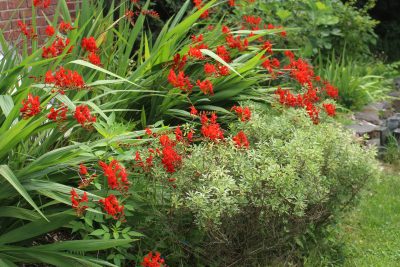
My tack in reining in crocosmia is lopping off all spent flower heads wherever I spot them with a hedge shears, and digging out seedlings where they are not wanted.
This summer I even noticed a crocosmia seedling in the meadow. Hmmm. I recently saw, in a video documentary about color in the natural world (Life in Color with David Attenborough, highly recommended), a field of crocosmia in its native habitat, the flowers hovering over the field like a red mist. Do I want that in my meadow? Should I transplant some corms there? Would my rich soil and the apparent footloose habit of crocosmia create a future nightmare? If so, could I awaken from that nightmare with one whole season of mowing that portion of the field? Grasses are pretty much the only plants that tolerate repeated mowing.
Permaculture Ideals
All this is part of the reason I wince when I’m accused of practicing permaculture (although my agricultural perspective and much of what I do does happen to align with those of permies). Permaculture’s origins are in the poor soils and dry climate of Australia. Plant a tree there, give it water, nutrients, mulch, and you’re not inviting half the plant world in as too-close neighbors. But try this here on my farmden — or in any other place with hot summers and sufficient natural rainfall — and those “neighbors” will be at the door.
Even among cultivated plants grown cheek to jowl in the various “guilds,” growth eventually becomes so rampant that it’s a major job to keep growth among plants balanced so each plant gets what it needs in terms of light and air.
Most permaculture sites outside of climates such as Australia, our Southwest, and the Mediterranean, that I have seen mingle plants nicely on paper and look good when first planted. After a few years, though, they become a tangled mess of plants with low yields of poor-quality fruits and vegetables.
Permaculture seems to encompass a broad philosophy, broad enough so a well-known local permaculturalist once told me, contrary to my opinion, that I was practicing permaculture. I asked him, “Ok, then; what isn’t permaculture?” He replied, “Everything is permaculture! (Except commercial agriculture).”
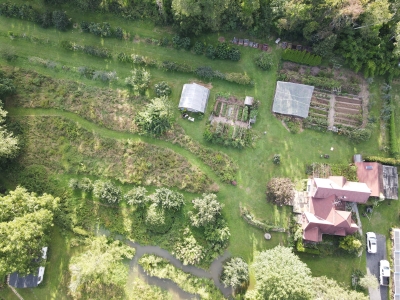
All this is not to say that I don’t side with permaculturalists in certain key practices. Like them, I minimize soil disturbance. I also practice interplanting, such as the blackcurrants and pawpaws, favor pest resistant species, such as hardy kiwifruit and gooseberries, and let my ducks have almost free rein here. I also have my requisite shiitake logs, fire wood pile, and solar cells.

